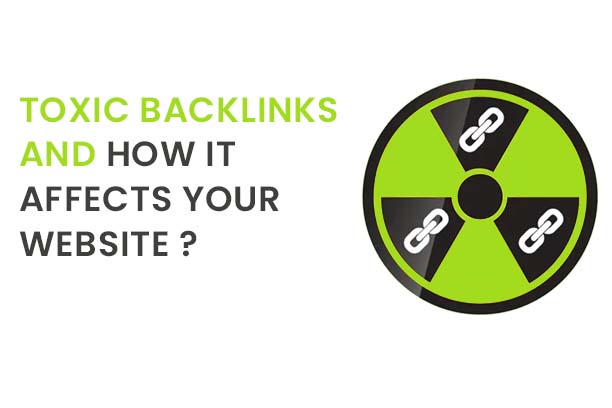

Posted by Rahul Kale on Fri, 19/05/2023

Backlinks are considered an essential part of any successful SEO strategy, but not all backlinks are created equal. Backlinks are links from other websites that point to your website, and they can help improve your search engine rankings. However, not all backlinks are created equal. Some links can actually harm your website and lead to penalties from search engines like Google. These harmful backlinks are known as toxic backlinks, and they can have a negative impact on your website's SEO.
A toxic link is a link from websites that have low domain authority or have been penalized by search engines. These links can be harmful to your website because they signal to search engines that your website is associated with low-quality or spammy websites. This can lead to a decrease in your website's search engine rankings and, in some cases, a penalty from search engines. These links are flagged from websites by search engines as spammy or violating search engine guidelines. These links are typically generated through black hat SEO techniques, such as link farming, link exchanges, and paid links. In this blog, we'll explore the effects of toxic back-links on your website, how to identify them, and how to remove them to protect your website's SEO with the best SEO services in India.
How Toxic Backlinks Affect Your Website
These links can harm your website's SEO in several ways. They can signal to search engines, that your website is associated with low-quality or spammy websites which will lead to a decrease in your website's search engine rankings and make it harder for potential customers to find your website. Such links lead to penalties from search engines which may result that your website being removed from search engine results altogether or being pushed down in the rankings.
When your website's search engine rankings decrease, it leads to a decrease in website traffic as less traffic means fewer potential customers and can be harmful to your business. Additionally, if your website is associated with low-quality or spammy websites, it can damage your brand's reputation which leads to a loss of trust from potential customers, and make it harder for you to grow your business. These links can harm your website's SEO in several ways. Here are some of the most common ways that can impact your website:
Decreased search engine rankings: These links give the signal to search engines stating that your website is associated with low-quality websites which leads to a decrease in your website's search engine rankings and makes it harder for potential customers to find your website.
Search engine penalties: In some cases, these links can lead to penalties from search engines. This can result in your website being removed from search engine results or degrade the ranking.
Decreased website traffic: When your website's search engine rankings decrease, it leads to a decrease in website traffic which leads to less traffic means fewer potential customers which can be harmful to your business.
Damaged brand reputation: If your website is associated with low-quality or spam websites then it can damage your brand's reputation and lead to a loss of trust from potential customers and it will become hard for you to grow your business.
Search engines consider toxic backlinks as spammy and irrelevant, and they can harm your website's search engine rankings and reputation. Some of the factors that can make a backlink toxic include:
Linking from spammy or low-quality websites: These are websites that are known to be involved in spammy or fraudulent activities, such as link farms, blog networks, or fake websites.
Linking from irrelevant websites: These are websites that are not related to your website's niche or industry.
Linking from websites with low domain authority: These are websites that have a low authority or trust score and are not considered to be credible sources of information.
Using exact match anchor text: Exact match anchor text is when a backlink uses the exact keyword phrase as the anchor text. This can be a sign of unnatural linking and can be considered spammy by search engines.
Identification of these links
Identifying toxic links can be a challenge, but there are several tools and techniques that can help. One of the most effective ways to identify these links is by using a backlink analysis tool. These tools can help you identify toxic links by analyzing the quality and relevance of the websites linking to your website. Some of the most popular backlink analysis tools include Ahrefs, SEMrush, and Moz.
Another way to identify toxic links is by checking your Google Search Console account. Google Search Console provides information about the backlinks pointing to your website. It can help you identify toxic links by showing you which websites are linking to your website and how many times they have linked to your website.
Monitoring your website's search engine rankings is another effective way to identify such links. If your website's search engine rankings suddenly drop, it could be a sign that you have a toxic-back link. By monitoring your website's search engine rankings, you can identify when something is wrong and take action to fix it.
Removing Toxic Backlinks
Removing these links can be a difficult and time-consuming process, but it's important to do so to protect your website's SEO. The first step in removing toxic-back-link is to contact the website owner and ask them to remove the link. Be polite and explain why the link is harmful to your website's SEO.
If you are unable to remove this link, you can disavow the link. Disavowing a link means telling search engines not to consider the link when calculating your website's search engine rankings. You can do this by creating a disavow file and submitting it to Google through your Google Search Console account.
Preventing this links
Preventing toxic links is always better than removing them. One way to prevent these links is by building high-quality backlinks. High-quality backlinks are links from websites that have a high domain authority and are relevant to your website's niche or industry. You can build high-quality backlinks by creating high-quality content that other websites will want to link to, such as blog posts, infographics, and videos.
Another way to prevent toxic links is by monitoring your website's backlink profile regularly. Regular monitoring can help you identify toxic links before they have a chance to harm your website's SEO.
In conclusion, toxic backlinks can have a severe negative impact on your website's search engine rankings and overall online reputation. It is crucial to regularly monitor your backlink profile and remove any toxic links to avoid penalties from search engines like Google. Seeking the assistance of a reputable SEO company can help you identify and remove these harmful links effectively. As such, if you're looking for the best SEO company in India to help you with your SEO services, make sure to choose one that has experience in dealing with toxic links and can provide you with a comprehensive link audit and removal strategy. With the right approach and tools, you can safeguard your website's online presence and ensure that your efforts toward improving your SEO are not in vain.